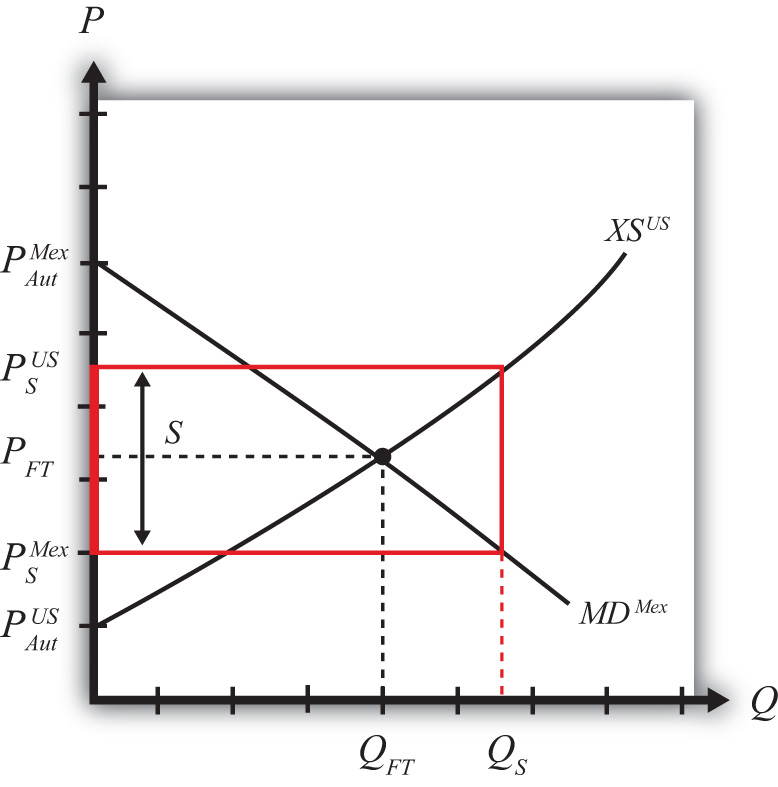This is “Export Subsidies: Large Country Price Effects”, section 7.16 from the book Policy and Theory of International Trade (v. 1.0). For details on it (including licensing), click here.
For more information on the source of this book, or why it is available for free, please see the project's home page. You can browse or download additional books there. To download a .zip file containing this book to use offline, simply click here.
7.16 Export Subsidies: Large Country Price Effects
Learning Objectives
- Identify the effects of an export subsidy on prices in both countries and the quantity traded in a large country.
- Know the equilibrium conditions that must prevail in a subsidy equilibrium.
Suppose the United States, the exporting country in free trade, implements a specific export subsidy on exports of wheat. A subsidy to exports will encourage the flow of wheat across the border. It will now cost less to move the product from the United States into Mexico.
As a result, the supply of wheat to the Mexican market will rise, causing a decrease in the price of wheat. Since the United States is assumed to be a large country, the price of all wheat sold in Mexico, both Mexican wheat and U.S. imports, will fall in price. The lower price will raise Mexico’s import demand.
The higher wheat supply to Mexico will reduce supply in the U.S. market and induce an increase in the U.S. price. The higher price will raise U.S. export supply.
A new subsidy-ridden equilibrium will be reached when the following two conditions are satisfied:
and
where S is the specific export subsidy, is the price in Mexico after the subsidy, and is the price in the United States after the subsidy. The first condition represents a price wedge between the final U.S. price and the Mexican price equal to the amount of the export subsidy. The prices must differ by the subsidy because U.S. suppliers of wheat must receive the same price for their product, regardless of whether the product is sold in the United States or Mexico, and all wheat sold in Mexico must be sold at the same price. Since a subsidy is paid to U.S. exporters, the only way for these price equalities within countries to arise is if the price differs across countries by the amount of the subsidy.
The second condition states that the amount the United States wants to export at its new higher price must be equal to the amount Mexico wants to import at its new lower price. This condition guarantees that world supply of wheat equals world demand for wheat.
The export subsidy equilibrium is depicted graphically in Figure 7.31 "Depicting a Subsidy Equilibrium: Large Country Case". The Mexican price of wheat falls from PFT to , which raises its import demand from QFT to QS. The Mexican price of wheat falls from PFT to , which raises its import demand from QFT to QS. The U.S. price of wheat rises from PFT to , which raises its export supply also from QFT to QS. The difference in the prices between the two markets is equal to the export subsidy rate S.
Figure 7.31 Depicting a Subsidy Equilibrium: Large Country Case

Key Takeaways
- An export subsidy will raise the domestic price and, in the case of a large country, reduce the foreign price.
- An export subsidy will increase the quantity of exports.
- The export subsidy will drive a price wedge, equal to the subsidy value, between the foreign price and the domestic price of the product.
- With the export subsidy in place in a two-country model, export supply at the higher domestic price will equal import demand at the lower foreign price.
Exercise
-
Jeopardy Questions. As in the popular television game show, you are given an answer to a question and you must respond with the question. For example, if the answer is “a tax on imports,” then the correct question is “What is a tariff?”
- The direction of change of the foreign price of soybeans when a large domestic country implements an export subsidy.
- The direction of change of the domestic price of corn when a large domestic country implements an export subsidy.
- The price of tea in the exporting country if the large exporter sets a subsidy of $0.45 per pound and if the importer country price is $3.25 inclusive of the subsidy abroad.
- Of increase, decrease, or stay the same, this is the effect on the quantity of wheat produced domestically when an export subsidy is implemented by a large exporter.
- Of increase, decrease, or stay the same, this is the effect on imports of wheat abroad if a wheat subsidy is implemented by a large exporting country.
- Of increase, decrease, or stay the same, this is the effect on domestic consumption of cotton if a cotton export subsidy is implemented by a large exporting country.




